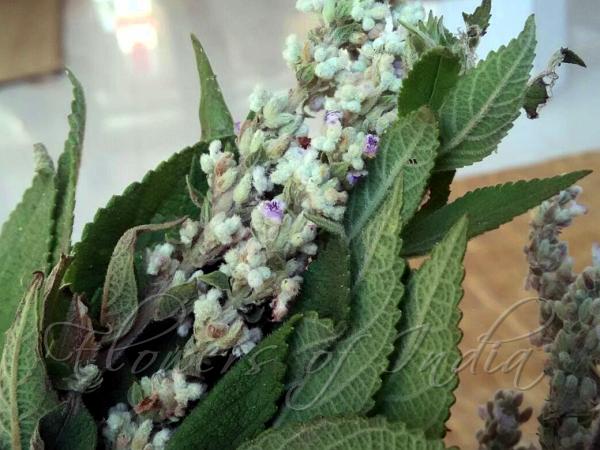|
| Three-Leaf Isodon |
|

|

|
|
|
|
Photo: |
Botanical name: Isodon ternifolius Family: Lamiaceae (Mint family)
Synonyms: Plectranthus ternifolius, Elsholtzia lychnitis, Rabdosia ternifolia
Synonyms: Plectranthus ternifolius, Elsholtzia lychnitis, Rabdosia ternifolia
Three-Leaf Isodon is a subshrub or a robust herb with
stems 0.5-2 m tall, obscurely angled, hairy woolly to velvet-hairy.
Leaves are usually in whorls of 3 or 4, narrowly ellipitc , 5.4-11 x
1.7-3.2 cm, base wedge-shaped, tip pointed or shortly tapering, margin
regularly minutely toothed, upper surface hairy, lower surface densely
white woolly; leaf-stalk 2-6 mm. Flowers are borne in woolly spikes,
22-40 x 1.7 cm long, in leaf-axils, in nearly erect dense cymes.
Flower-stalks are up to 1.5 mm. Calyx is somewhat two-lipped,
bell-shaped, about 2 mm,densely white hairy; teeth 1-1.5 mm; fruiting
calyx tubular, up to 5 mm long, prominantly ribbed. Flowers are whtie
to pale violet, 6.5 mm; tube about 2 mm, swollen, upper lip erect or
recurved; lower lip straight. Stamens do not exceed lower lip, curving
up at tip. Nutlets are oblong oviod,rounded trigonous, about 2 mm.
Three-Leaf Isodon is found in the Himalayas, Myanmar, S. China at
altitudes of 100-2200 m.
Medicinal uses: In Manipur, the leaves and
flowers are used in preparing Chinghi, a hair-care lotion. Plant
decoction is is prescribed as a bath in skin diseases.
In Manipur, the leaves and
flowers are used in preparing Chinghi, a hair-care lotion. Plant
decoction is is prescribed as a bath in skin diseases.
Medicinal uses:
 In Manipur, the leaves and
flowers are used in preparing Chinghi, a hair-care lotion. Plant
decoction is is prescribed as a bath in skin diseases.
In Manipur, the leaves and
flowers are used in preparing Chinghi, a hair-care lotion. Plant
decoction is is prescribed as a bath in skin diseases. | Identification credit: Huirem Bhabini | Photographed in Imphal, Manipur. |
• Is this flower misidentified? If yes,